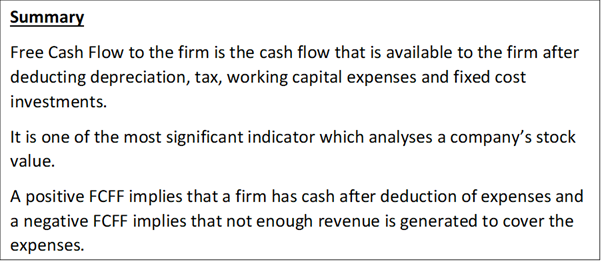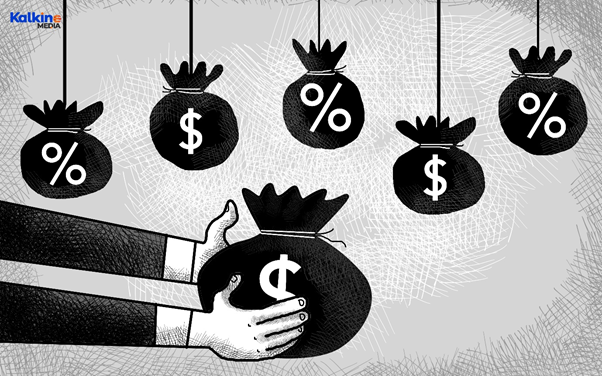What do you mean by Free Cash Flow to a Firm?
Free cash flow to the firm (FCFF) addresses the measure of income from activities accessible for circulation after the deduction of representing depreciation costs, charges, working capital, and speculations. FCFF is an estimation of an organisation's benefit after all expenses and reinvestments. It is one of the numerous benchmarks used to look at and dissect an association's monetary wellbeing.

Copyright © 2021 Kalkine Media
Understanding Free Cash Flow to Firm
Free Cash Flow to Firm is the income accessible to all financing suppliers such as obligation holders, favoured investors, regular investors, convertible bond financial backers, and so forth. FCFF addresses the money accessible to financial backers after an organization pays all its business costs, puts resources into current resources (e.g., stock), and puts resources into long-haul resources (e.g., hardware). FCFF incorporates bondholders and investors as recipients while considering the cash left over for financial backers. This can likewise be alluded to as unlevered free income, and it addresses the excess income accessible to a business if it was a debt-free company. A typical beginning stage for computing it is Net Operating Profit After Tax (NOPAT), which can be gotten by increasing Earnings Before Interest and Taxes (EBIT) by (1-Tax Rate). We eliminate all non-cash costs and eliminate the impact of CapEx and changes in Net Working Capital, as the center tasks are the core interest.
The FCFF estimation is an indicator of an organisation's tasks and its presentation. FCFF considers all money inflows as incomes, all money outpourings as standard costs, and all reinvested money to develop the business. The cash leftover in the wake of directing this load of tasks addresses an organisation's FCFF.
Free income is the primary monetary pointer of an organisation's stock worth. The worth/cost of a share is viewed as the summation of the organisation's expected future cash flows. Nonetheless, stocks are not, in every case, precisely estimated. Understanding an organisation's FCFF allows financial backers to test whether a stock is genuinely or reasonably priced. FCFF additionally addresses an organisation's capacity to deliver profits, direct offer repurchases, or payback obligation holders. Any financial backer hoping to put resources into an organisation's corporate security or public value should check its FCFF.
Positive FCFF esteem demonstrates that the firm has cash staying after costs. A negative worth shows that the firm has not produced sufficient income to take care of its expenses and venture exercises. A financial backer should burrow further to evaluate why expenses and speculation surpass revenues in the last case. It very well may be the consequence of a particular business reason, as in high-development tech organizations that take reliable external speculations, or it very well may be a sign of monetary issues.
FCFF is a significant piece of the Two-Step DCF Model, which is a realistic valuation technique. The subsequent advance, where we compute the terminal worth of the business, may utilize the FCFF with a terminal development rate. DCF Analysis is a vital Business Valuation method, as it assesses the characteristic value of the company by taking a gander at the money creating capacity of the business. On the other hand, Comps and Precedent Transactions utilize a Relative Valuation approach, which is essential in Private Equity because of confined admittance to data.

Copyright © 2021 Kalkine Media
Even though it's anything but an abundance of essential data that financial backers appreciate, FCFF isn't faultless. Cunning organisations have space with regard to bookkeeping skillful deception. Without an administrative norm for deciding FCFF, financial backers frequently differ on precisely which things ought to and should not be treated as capital consumption.
Financial backers should accordingly watch out for organizations with undeniable degrees of FCFF to check whether these organizations are under-detailing capital uses and innovative work. Organisations can likewise briefly help FCFF by loosening up their installments, fixing installment assortment strategies, and exhausting inventories. These exercises decrease current liabilities and changes to working capital, yet the effects will probably be impermanent.
The are many variations in deriving the FCFF, which is based on the availability of data. All the formulas have been substituted with some of the other variables. Some of the formulas are as follows:

Where:
NI = Net Income
NC = Non-cash expenses
WC = Working Capital
I = Interest
TR = Tax Rate
LI = Long term investments

Where:
CFO = Cash Flow from Operations
IE = Interest Expense
TR = Tax Rate
CAPEX = Capital Expenditure

Where:
EBITDA = Earnings Before Income, Taxes, Depreciation, and Amortization

Where:
EBIT = Earnings Before Interest and Taxes
Frequently Asked Questions
What is the difference between cash flow and free cash flow to the firm?
Cash flow is the net measure of cash and cash equivalents being moved into and out of an organisation. Positive income shows that an organization's liquid resources are expanding, empowering it to settle obligations, reinvest in its business, return cash to investors, and pay costs. Cash flow is accounted for on the cash flow statement, which contains three areas itemising exercises. Those three segments are cash flow from operations (CFO), cash flow from investing activities (CFI), and cash flow from financing activities (CFI).
FCFF is the income an organization produces through its tasks after taking away any money costs for interest in fixed resources like property, plant, and hardware. After depreciation costs, charges, working capital, and premium are represented. At the end of the day, free cash flow to the firm is the money left over after an organisation has paid its working costs and capital uses.
 Please wait processing your request...
Please wait processing your request...